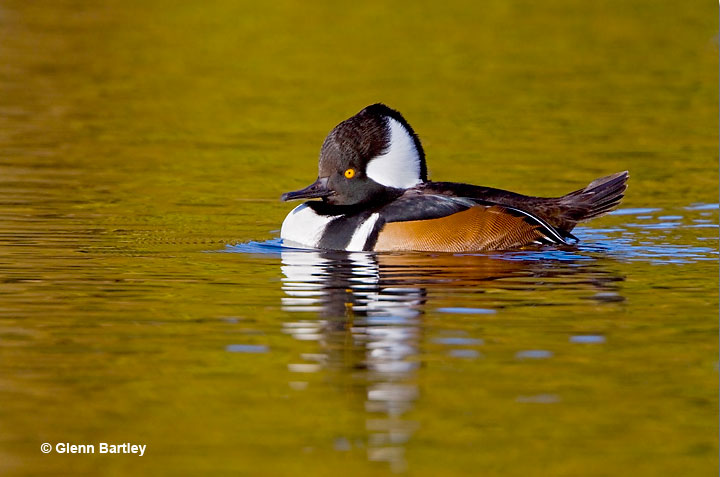Hooded Mergansers (Lophodytes cucullatus) are small, crested ducks known for their striking appearance, with the male sporting a distinctive black and white hood and the female a cinnamon-brown crest.
They are skilled divers and feed primarily on small fish, insects, and crustaceans found in shallow wetlands, ponds, and streams.
Hooded Mergansers are also known for their unique courtship displays, where males puff up their crests, bob and throw their heads, and make croaking calls to attract females.
On this page
Breeding Male
Male Hooded Mergansers have a black back, neck, and head with white markings. Their undersides and breasts are white, whereas their sides are deep chestnut brown.
Males have a huge black crest with a white patch on it. The crest can be raised or lowered, which changes the overall shape of the head and the size of the white patch. Males have bright yellow eyes.
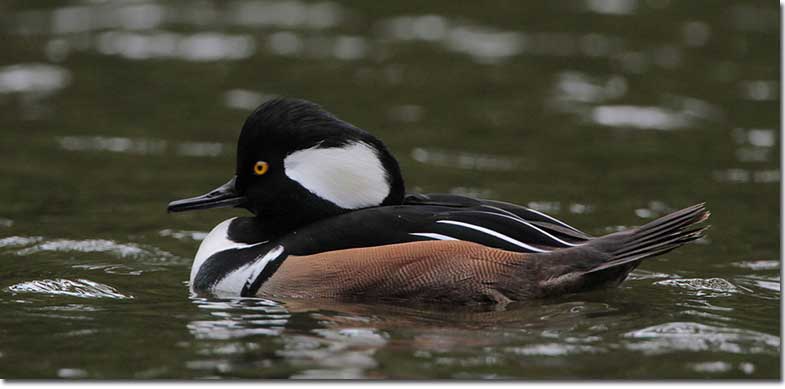
Male Hooded Merganser
Female
Female Hooded Mergansers appear brown overall. They have grayish-brown plumage with a narrow white patch on their lower breasts and bellies and white stripes on their wings.
Their cinnamon-colored crests are almost as impressive as the males’. Females have brown eyes.
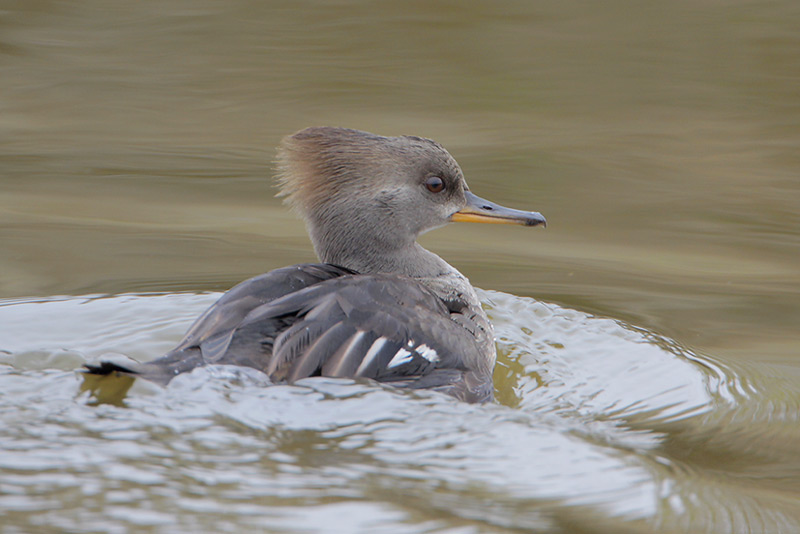
Female Hooded Merganser
Juvenile
Hooded Mergansers have 5-13 white, nearly spherical eggs in a clutch. Only the female incubates the eggs, which takes around 26-41 days, and the young will leave the nest a day after hatching. The mother bird will look after the ducklings for several more weeks. However, like most ducklings, they will forage food on their own.
Juvenile Hooded Mergansers appear very similar to females, having an overall dark brown plumage and a buff-colored underside. Their crests are very small compared to adults and they have dark brown eyes.
These small ducks can grow 16-19 inches long and weigh 16-31 ounces.
Habitat
Hooded Mergansers prefer to nest in forested wetlands, such as along forested creeks, and narrow rivers. In the winter, you can find it in shallow freshwater habitats, brackish bays, tidal creeks, ponds, and estuaries. During migration, you can see them in more open aquatic habitats as well.
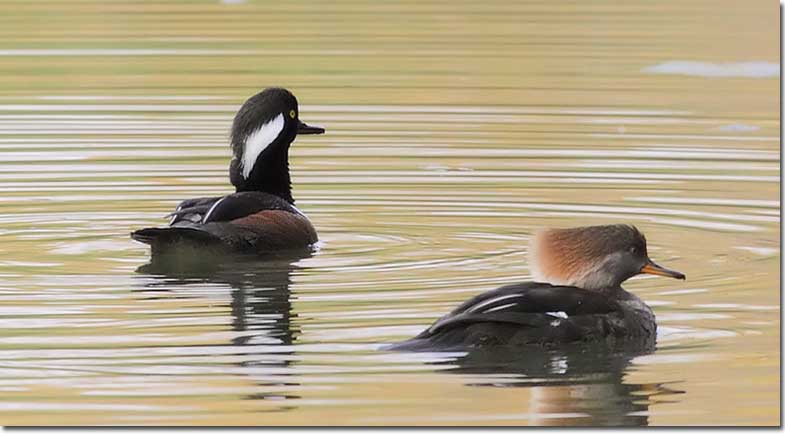
Hooded Merganser pair
Hooded Mergansers nest in cavities, usually in trees close to the water and 10-50 feet above the ground. They also accept artificial nest boxes. The inside is usually lined with wood chips and debris, which the female shapes into a cup and furthers lines with her own down-feathers.
Diet
Hooded Mergansers are carnivores that feed on fish, aquatic insects, mollusks, amphibians, tadpoles, crustaceans, and a small amount of plant material.
The birds feed in aquatic habitats with clear and shallow water, such as rivers, streams, and forest ponds. They dive underwater and swim using their feet. After locating their prey by sight, they grab it using their slender bills.
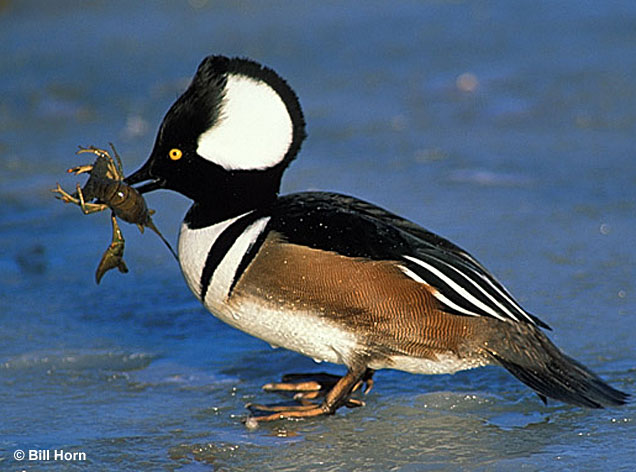
Ducklings will also dive underwater for food, although the duration and depth of their dives are usually shorter, and may opt for swimming with just their heads underwater.
Behavior
Hooded Mergansers are monogamous, and they can be found in pairs or small groups of up to 40 birds. In courtship displays, the males raise their crests, shake and throw their heads. Females bob their heads up and down.
Once the female starts incubating, the male abandons the female, leaving her to fend for herself and for her young. Females act injured in an attempt to lure predators away from the nest.
Range (and seasonal changes)
Hooded Mergansers range throughout most of North America. They have two large year-round populations, one expanding east of the Mississippi River, and the second smaller one extending from the southern half of British Columbia to Washington, the northern part of Idaho, and westernmost Montana.
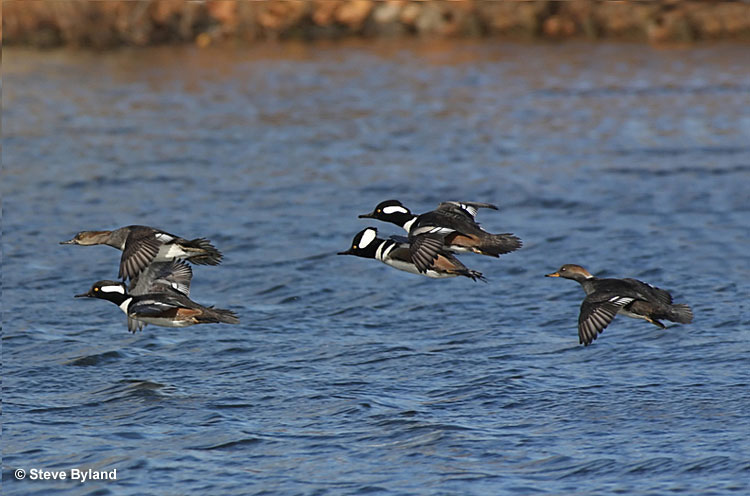
Their breeding range extends from Missouri to southern Canada and from eastern North Dakota and Saskatchewan to Nova Scotia. In the winter, they migrate south and southwest only as much as they need to find ice-free waterbodies.
Hooded Mergansers are listed as of least concern on the IUCN Red List. The main threats include habitat loss and diminished food supply.
Wing shape
Hooded Mergansers have a wingspan of 23-26 inches. They have short and narrow wings and a relatively long and rounded tail. In flight, you can recognize them by very rapid and shallow wingbeats.
To take flight, they run across water, and to land, they skid along the water spreading their wings to break the speed.
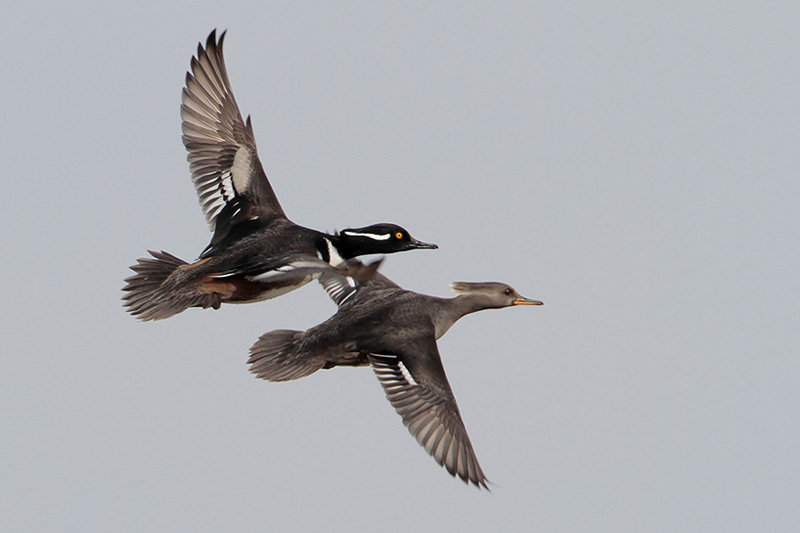
Fun Facts
- Hooded Mergansers may lay eggs in the nests of other birds.
- Hooded Mergansers have adapted to hunting underwater by having a third “eyelid” that helps them protect their eyes and improve vision.
- Hooded Mergansers are the smallest mergansers found in North America.
- Hooded Mergansers are capable of and willing to hybridize with other species of ducks, such as Common Goldeneyes, Buffleheads, and Wood Ducks.
Call
These birds are usually silent, making sounds only during courtship or while tending to their young. During courtship, male Hooded Mergansers sound like frogs to which females answer with a gack call.
Females call their ducklings with a low cro-cro-crook call.
Similar Species
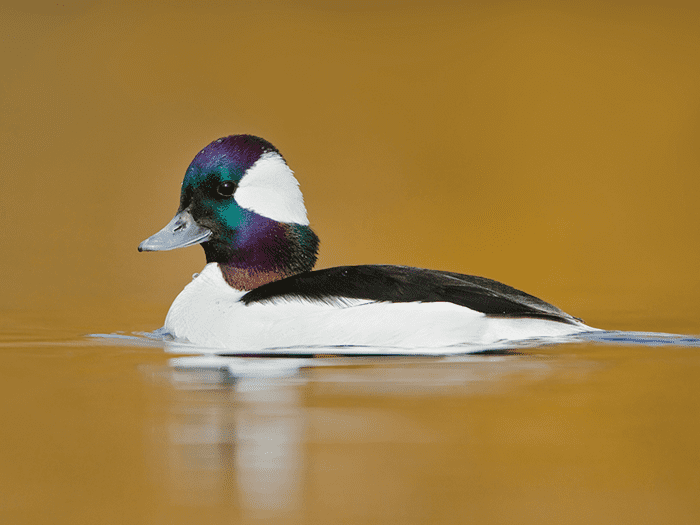
Male Bufflehead
Hooded Mergansers and Buffleheads look fairly similar, but there are still a few key differences.
Most noticeably – Hooded Mergansers have brownish plumage on their sides, while Buffleheads have simple black and white plumage.
Another thing to note is that they have similar plumage on their heads, but Buffleheads have some iridescent plumage on their faces.
Frequently Asked Questions
Are mergansers rare?
Hooded Mergansers are rather common on small, clear, and shallow bodies of water throughout their range. They are most common around the Great Lakes.
Is a hooded merganser a duck?
Hooded Mergansers are small ducks.
Why is it called a hooded merganser?
The Hooded Merganser was named after its large crest that resembles a hood.
Where do Hooded Mergansers migrate?
Hooded Mergansers migrate south and southwest for the winter, usually only as far as necessary to reach ice-free bodies of water.

